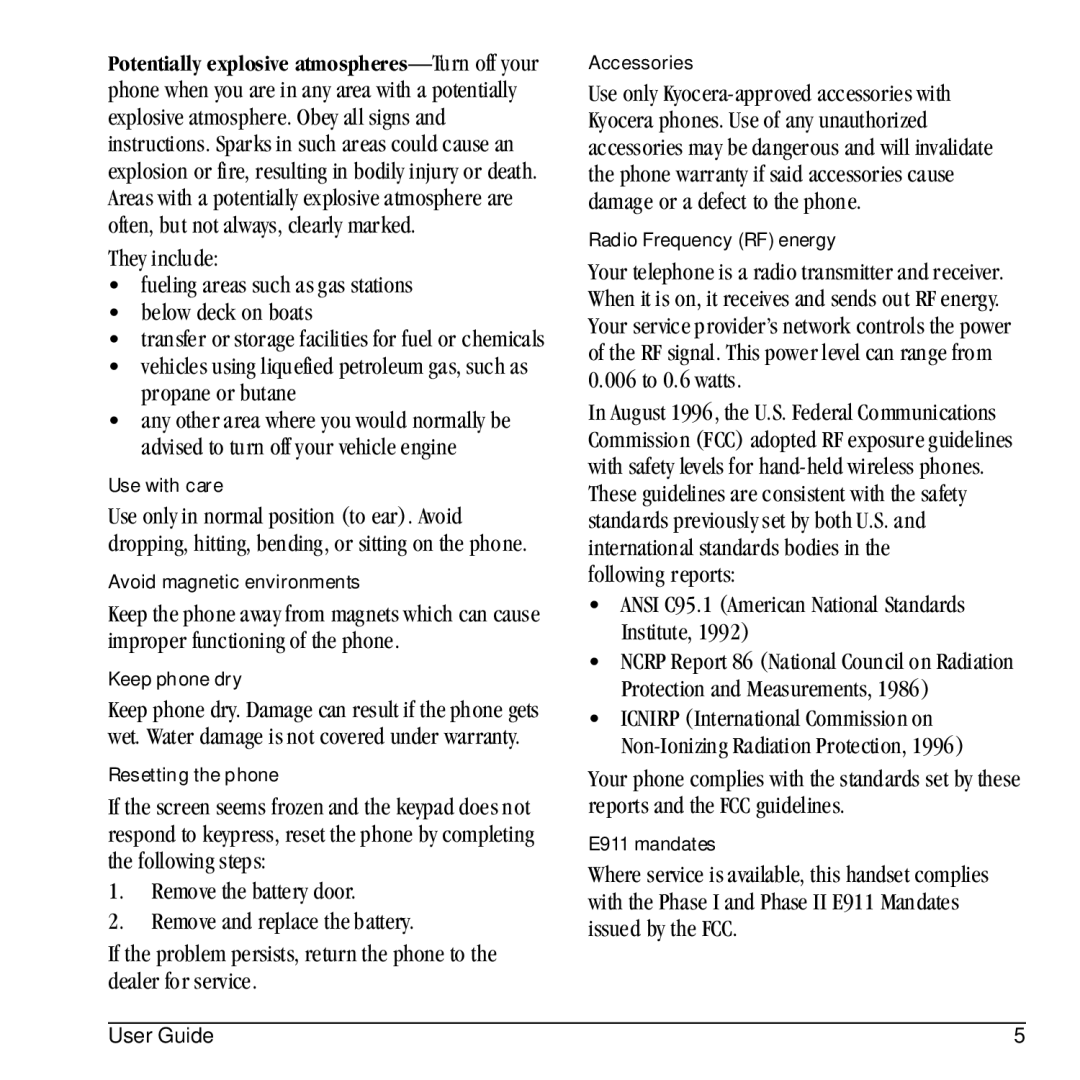User Guide
Or approved by KWC may violate FCC RF exposure guidelines
Product
82-N0247-1EN, Rev
User Guide
Potentially unsafe areas
Always keep the phone at least six inches
Transfer or storage facilities for fuel or chemicals
To purchase accessories, visit
Table of Contents
Voice Commands
Install the Battery
Phone Battery
Charge the Battery
To install the battery Hold the phone face down
Supervise all battery usage by children
Battery Safety Guidelines
Common Causes of Battery Drain
To attach the lanyard Hold the phone face down
Attach the Lanyard
Phone is shown here in the open position Home screen
Phone Overview
Get to Know Your Phone
Lightpipe LED Behavior
These icons may appear on your phone’s screen
Screen Icons
Main Menu
Guide Conventions
Power Phone Up
Call Features
Make Phone Calls
Answer Phone Calls
End Phone Calls
Volume Control
Activate Voice Dialing
Use Speed Dialing
Call Emergency Service
Emergency Services
Exit Emergency Services
When you have completed the emergency call Select Exit
Text Entry Modes
Text Entry
Enter Numbers
Enter Words Letter by Letter
Enter Words Quickly
Enter Symbols
Change Modes
Change Capitalization
Text Entry Quick Reference
Use Browser Options
Browser
Launch Browser
Use a Bookmark
Search for a Web Site
Check Browser Alerts
Set Web Prompt
View Contacts Directory
Contacts
Add Contacts
Add Contact from Home Screen
Add Contact from Contacts Menu
Customize Contacts
Add Code or Extension
Edit Contact Details
Customize an Email Address
Customize a Number
Customize an IM Address
View Address displays the email address
View Address displays the street address
Customize a Note
Assign Ringer to a Contact
Assign Picture to a Contact
Contact Groups
Assign Number Type
Send a vCard
Search Contacts
You can delete all your contacts
Erase All Contacts
Count Contacts
Take a Picture
Camera
Change Camera Options
Select Menu Camera
White Balance adjusts for different lighting
Camera Indicators and Icons
Text Messages
Messaging
Create a Text Message
Attach QuickText and other Extras
Retrieve a Text Message
Use Text Message Options
View a Text Message
Message Notifications
Select Menu Messaging New Pic Msg
Multimedia Messages
Create a Multimedia Message
Complete your message Select Send
Use Multimedia Message Options
Preview Message plays the message
Prompt Mode
Auto Retrieve Mode
Retrieve a Multimedia Message
View a Multimedia Message
Voicemail
Configure your Voicemail
Check your Voicemail
Pause / Resume pauses or continues the message slides
Work with Messages
Erase Messages
Complete Messages in Drafts Folder
Incoming Calls while Creating Messages
View Sent Messages
View Failed or Pending Messages
Set Alerts
Message Settings
Set Message List View
Set Signature
Enable CC/BCC Fields
Enable Auto Retrieve
Enable Save to Sent
Enable Auto-Erase
Request Message Receipts
Set Default Text
Set Voicemail Number
Erase Recent List
Send as vCard sends the group as a vCard
Message Groups
You can create groups for messaging
Call Lists
Recent Calls
View Call Lists
Deal with a Missed Call
Erase Call Lists
View Call Timers
View Data Counter
Settings Menu
Settings
Enable Bluetooth
Bluetooth
Bluetooth Pairing
Create a Custom Menu
Bluetooth Device Options
Use Bluetooth
Select Menu Settings Bluetooth My Devices
Connect to a Device
Set Ringer Mode
Bluetooth Settings
Sounds
Ringers
Set Power On/Off Sounds
Volume
Set Flip Sounds
Keypad
Display
Set Backlight Duration
Set My Banner
Set Light Pipe Behavior
Set Brightness
Enable Auto-Hyphenation
Enable Airplane Mode
Convenience
Set External Display
Enable Hold Call
Enable 1-Touch Dialing
Hold Call
Place a Call on Hold
Voice Features
Set Display Results
Set Expert Mode
Set Digit Lengths
Voice Answer
Accessories
Enable Date Mode
Enable Hearing Aid
Enable Privacy Alert
Network
Enable Roaming Service Alert
Enable Voice Privacy
Set Roaming Restrictions
Set Phone Line
Security
Enable Roaming Call Alert
Set Location Information
Set Web Alerts
Assign ICE Numbers
Set Limit Calls
Erase All Contacts
Unlock Phone
Select Menu Settings Phone Info and one of the following
You can access information regarding your phone
View Phone Information
Change Lock Code
Scheduler
Tools
Voice Memo
View by Date
View Events
Select Save to save the event
You can view the events saved to the scheduler
Modify an Event
Scheduler Settings
View by List
Select Menu Tools Scheduler View All Events
Set an Alarm
Alarm Clock
Set the Quick Alarm
Use Tip Calculator
Use Stopwatch
Use Timer
Memopad
Write a Memo
Use a Memo
World Clock
Set World Clock
Search World Clock
Download an Application
Brew Apps
How does Brew Work?
Open an Application
Disable an Application
View Application Details
Remove an Application
Browse Camera Pictures
Media Gallery
Modify a Picture
Select Options Modify Options and one of the following
Browse Wallpapers
Browse Saved Images
To browse the saved images on your phone
To browse the wallpapers on your phone
Browse Screensavers
Edit Wallpaper Shuffle
Browse Caller IDs
Browse Saved Sounds
Edit Ringer Shuffle
Browse Ringers
Browse Voice Memos
Select Menu Media Gallery Sounds Ringer Shuffle
You can delete your unlocked media files
Delete All Files
Playback Tools
Voice Dial List
Voice Commands
Voice Commands
Call a Number
Call a Contact
Use Shortcuts
Press the End key to end the call
Find Contacts
Voice Command Settings
Get Help
Qualified Service
User Guide
Customer Support
Phone Accessories Become a Product Evaluator
Picture compression
Index
Bookmarks, 24 BREW, 71 brightness, 54 browser
Changing modes, text entry, 21 color themes
Connecting Bluetooth devices, 50 contacts Adding
Custom
Icons, 14 Multimedia messages, 38 text message
Quick alarm, 68 quicktext
Playback tools, 77 power
Request receipt, 37 retrieving, 38 saving Send later
Multimedia messages, 38 text messages
Request read receipt, 44 request receipt, 35, 44 retrieving
Lock code, 64 locking phone, 62 settings
Speed
Training
